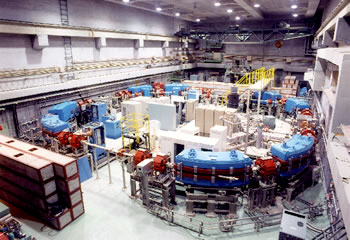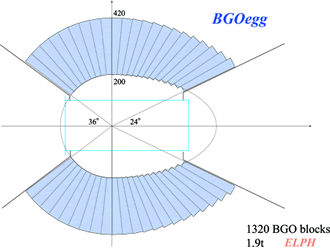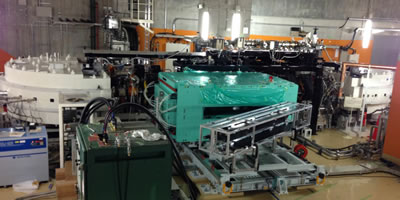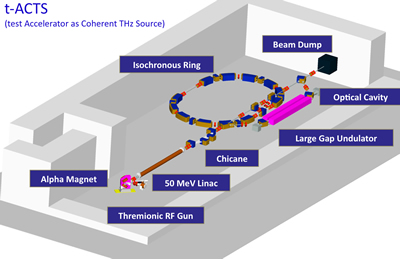Experimental Nuclear and Particle Physics
Nuclear Science
Staff
| Professor : | Hiroaki Ohnishi | Toshimi Suda HP | Norihito Muramatsu | |
| Associate Professor : | Shigeru Kashiwagi | Fujio Hinode | Hidetoshi Kikunaga | |
| Assistant Professor : | Manabu Miyabe | Toshiya Muto | Atsushi Tokiyasu | Yuki Honda |
| Yuji Matsumura | Takuya Yokokita |
Research

Research Center for Electron Photon Science (ELPH), a university-based laboratory, is a Joint/Usage Research Center approved by the Ministry of Education and Science.It aims to promote fundamental researches and applications in nuclear science as well as to educate students and young researchers over the framework of a university.ELPH operates a high intensity 60 MeV electron linear accelerator (LINAC)and a synchrotron currently boosting electrons injected by an injector LINAC from 90 MeV to 1.3 GeV.The 60 MeV LINAC provides an intense pulsed beam and has been used in a wide range of research fields, such as nuclear physics, solid state physics, radiochemistry, biology, engineering, and so on.
The 1.3 GeV synchrotron produces GeV photon beams by means of internal radiators placed in the circulating electrons. Two energy-tagged photon beamlines are utilized for experiments mainly in nuclear physics.
The research program of Nuclear Science Group has four main components:
quark nuclear physics, nuclear structure physics, accelerator science,
and radiochemistry as follows.
Quark Nuclear Physics

The particle is expressed as an excited state of a quantum field and the vacuum corresponds to the lowest energy state of the quantum field. Thus the particle and vacuum are mutually prescribed. The structure of QCD vacuum is one of the most important objects to be studied in quark nuclear physics in this regard. It is necessary to elucidate the hadron structure in a nucleus as well as in free space since the QCD vacuum is expected to change inside the nucleus where an extremely high density world opens up. This kind of study can be made via photoproduction of a meson by employing a tagged photon beam capable of going inside the nucleus and a 4π electromagnetic (EM) calorimeter to detect photons coming from decay of the meson. Two 4π EM calorimeters, FOREST and BGOegg consisting of 1320 BGO crystals, have been constructed at ELPH for this purpose. Both of the calorimeters are now in operation at ELPH and SPring-8/LEPS, respectively.
Exotic Nuclear Physics
One of burning issues of nuclear physics today is to understand the internal structure of short-lived exotic nuclei, some of which have been observed to have peculiar structures, such as skin, halo, magicity loss etc., which were totally unknown in stable nuclei.
Using a novel experimental technique we have invented, named SCRIT (Self-Confining RI Target), we aim at studying their internal structures by electron scattering. Although electron scattering is the best probe for the structure studies of atomic nuclei, no electron scattering has ever been conducted for short-lived nuclei due to its difficulties.

After successful demonstration of our novel SCRIT technique, we constructed the world’s first electron scattering facility dedicated to exotic nuclei. This brand-new facility, SCRIT Electron Scattering Facility, will soon start its operation. We are going to open a door to completely unexplored research field in nuclear physics. The world’s first electron scattering off short-lived nucleus will take place in the year 2014.
Beam Physics/Accelerator Science
http://www.lns.tohoku.ac.jp/~scrit/SCRIT_Sendai_e/SCRIT_Sendai_e/SCRIT_MainPage.html

Non-linear beam dynamics in circular accelerators is studied by using the STB ring operated at the storage ring mode. Slow beam extraction results from stochastic excitation of the betatron oscillation by applying white noise perturbation has been theoretically and experimentally examined. In addition, fundamental accelerator physics for generation of very low beam emittance is progressed in collaboration with SPring-8.
Furthermore production of a low emittance beam using an RF gun for a high brilliant coherent light source such as the free electron laser is also studied.
Radio-chemistry
Photo-nuclear reactions have been studied and applied to micro analysis of various elements in the environment and in biological material. Recently, a method to produce a radioactive fullerene (C60) has been developed by bombarding fullerenes with electrons and charged particles. The production mechanism is being investigated in detail.

